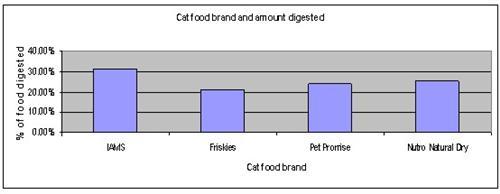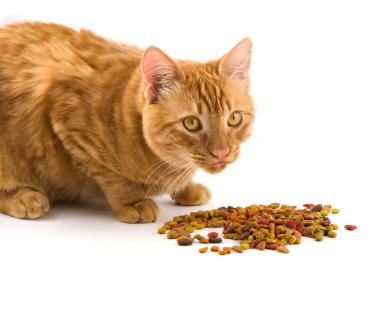| Complexity level: | 6 |
| Project cost ($): | 30 |
| Time required: | It will take an hour to prepare for this science project and 3 days to conduct it |
| Material availability: | The cat food can be purchased at a pet store or at a supermarket. Lab equipment is required |
| Safety concerns: | Be carefuly when handling acid. |
Hypothesis
The IAMS brand which is also the most expensive will have the highest percent of food digested and absorbed through the cat’s intestine.
Overview
Cat food and digestion
Cats are carnivorous animals; they survive on meat. Ironically, they are not able to synthesize some of the amino acids that is contained in meat. Therefore, it is important for cats to consume a lot of protein from meat in order to meet their nutritional requirements.
Dry cat food normally contains about 40% carbohydrates. Carbohydrates hold the crunchy kibble pieces together. The kibble helps reduce the build up of tartar and plaque in the felines’ teeth. However, as carnivores, the cats will have difficulty digesting carbohydrates.
As a carnivorous animal, the cat has jaws that will only be able to cut, tear and bite. Their teeth will not be able to grind food and thier saliva does not contain the required enzymes to digest starch and carbohydrates.
A cat has a very small stomach. The stomach stores the meat that a cat has consumed. Stomach acid dissolves and denatures proteins in the meat. The digested food bits are released in a gradual manner into the small intestine. There, enzymes from a cat’s liver and pancreas convert fat into fatty acid, and protein into amino acid. Only a small amount of carbohydrates are digested.
Scientific Terms
Materials
The materials required for the experiment are as follows:
- 150g of 4 brands of cat food (IAMS, Friskies, Pet Promise and Nutro Natural Dry)
- 1200ml of hydrochloric acid
- a large beaker
- pH paper
- 4 beakers
- 1 measuring cylinder
- 1200ml of meat tenderizer
- tap water
- a digital weighing scale
- a strainer
- a black marker pen
Procedure
1. For this science fair project, the independent variable is the brand of cat food (IAMS, Friskies, Pet Promise and Nutro Natural Dry). The dependent variable is the amount of food that is digested by the cat. The constants (control variables) are the amount of cat food that the cat is fed, the pH level of hydrochloric acid, the amount of acid used, and the amount of meat tenderizer used.
2. Label the4 beakers according to the cat food brands: IAMS, Friskies, Pet Promise and Nutro Natural Dry.
3. Pour hydrochloric acid into a larger beaker and mix it with water until the mixture is of the pH level 2. This acid solution is to simulate the acidity inside a cat’s stomach. Using a measuring cylinder, pour 300ml of the acid solution into each of the 4 beakers.
4. Place about 150grams of each brand of cat food in the beakers, according to their labels. Put the 4 beakers aside for the next 12 hours. By then, the protein that is in the cat food should have been softened and denatured by the acid.
5. After 12 hours, drain the hydrochloric acid using a strainer. Pour 300ml of meat tenderizer into each beaker. The meat tenderizer contains enzymes that are similar to those found in a cat’s small intestine. Put the 4 beakers aside for the next 12 hours. By then, the protein that is in the cat food should have been reduced to amino acids.
6. After 12 hours, strain the meat tenderizer from the beakers. Allow the residue in the beakers to dry for a day. Weight whatever cat food is left – this weight will represent the weight of the cat’s feces. Measure it using a digital weighing scale and record this weight in the table below.
7. Calculate the percentage of digested food with this formula:
% food digested = (Start weight – Final weight)/ Start weight x 100%

Results
It is observed that the IAMS cat food brand has the largest percent of food "digested" during the experiment.
| Brand of cat food | Start weight (grams) | Final weight (grams) | % digested |
| IAMS | 150g | 103g | 31.30% |
| Friskies | 150g | 118g | 21.30% |
| Pet Promise | 150g | 114g | 24.00% |
| Nutro Natural Dry | 150g | 112g | 25.30% |
The graph below represents our results:

Conclusion
The hypothesis that the IAMS brand which is also the most expensive, will have the highest percent of food digested and absorbed through the cat’s intestine, is proven to be true.
Cat food comes in the form of dry food, soft moist food and canned food. Dry food is crunchier and can be stored for a longer period of time than other types of food. Soft moist foods taste better and are convenient to serve. Canned foods taste the best but they need to be refrigerated once the cans are opened. All of the 3 types of cat food provide a cat with enough nutrition and ensure that it has a balanced diet.
Also consider
Feed the cat with dry food, soft moist food and canned food. Compare the results.
Examine the differences in nutrient content of various brands of dog food.
References
Natural diet - http://www.blakkatz.com/dryfood.html
Comparing cat food - http://www.purina.com/cats/food/ComparingCatFoods.aspx

